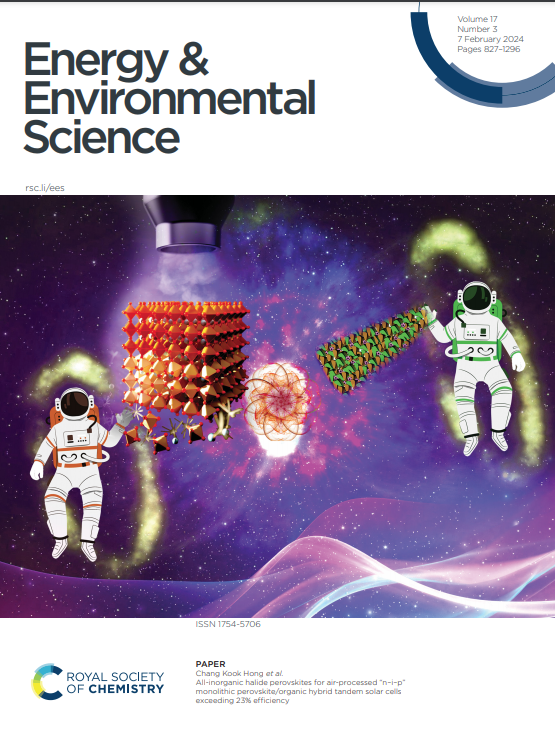一种用于固态钠电池的紧凑的Na2.5PS3.5F0.5电解质
IF 30.8
1区 材料科学
Q1 CHEMISTRY, MULTIDISCIPLINARY
引用次数: 0
摘要
固态钠电池(nassb)由于其大规模的能量存储特性而具有很大的前景。然而,广泛使用的硫化物电解质Na3PS4与阳极发生严重的界面反应,在循环过程中容易被Na枝晶穿透。本文提出了一种具有Na3PS4综合优势的新型Na2.5PS3.5F0.5 (NPSF)电解质。在室温下,它的Na+电导率为0.27 mS cm−1,电子电导率为3.9 × 10−6 mS cm−1。受益于f掺杂,NPSF表现出优异的机械致密性,从而通过简单的冷压工艺获得具有最小缺陷的致密电解质颗粒。采用Na15Sn4电极组装而成的对称电池具有较高的抗枝晶性能。此外,NPSF在Na15Sn4中也表现出更高的电化学稳定性,使其成为Na3PS4的全面升级。进一步开发了坚固的Na15Sn4/硬碳复合电极与NPSF电解质配对,其中组装的对称电池可以显示出4.5 mA cm−2的高临界电流密度。集成的nassb全电池具有一系列高性能的4v级氧化物阴极,具有高比能量和功率密度,以及超过1000次循环的长循环寿命。本文章由计算机程序翻译,如有差异,请以英文原文为准。

A compactable Na2.5PS3.5F0.5 electrolyte for solid-state sodium batteries
Solid-state sodium batteries (NaSSBs) hold great promise due to their large-scale energy storage properties. However, the widely used sulfide electrolyte, Na3PS4, shows severe interface reaction with the anode and can be easily penetrated by Na dendrites during cycling. Here we propose a new type of Na2.5PS3.5F0.5 (NPSF) electrolyte with comprehensive advantages over Na3PS4. It demonstrates a Na+ conductivity of 0.27 mS cm−1 and a low electronic conductivity of 3.9 × 10−6 mS cm−1 at room temperature. Benefiting from F-doping, NPSF demonstrates superior mechanical compactability, thus obtaining a dense electrolyte pellet with minimal defects, through a simple cold-pressing process. The assembled symmetric battery with Na15Sn4 electrodes shows highly improved dendrite-resistant capability. Moreover, NPSF also exhibits increased electrochemical stability with Na15Sn4, enabling it to be a comprehensive upgrade over Na3PS4. A robust Na15Sn4/hard carbon composite electrode is further developed to pair with an NPSF electrolyte, where the assembled symmetric battery can demonstrate a high critical current density of 4.5 mA cm−2. Integrated full batteries of NaSSBs with a series of oxide cathodes of the high-performance 4 V class are achieved with high specific energy and power densities, as well as a long cycle life of over 1000 cycles.
求助全文
通过发布文献求助,成功后即可免费获取论文全文。
去求助
来源期刊

Energy & Environmental Science
化学-工程:化工
CiteScore
50.50
自引率
2.20%
发文量
349
审稿时长
2.2 months
期刊介绍:
Energy & Environmental Science, a peer-reviewed scientific journal, publishes original research and review articles covering interdisciplinary topics in the (bio)chemical and (bio)physical sciences, as well as chemical engineering disciplines. Published monthly by the Royal Society of Chemistry (RSC), a not-for-profit publisher, Energy & Environmental Science is recognized as a leading journal. It boasts an impressive impact factor of 8.500 as of 2009, ranking 8th among 140 journals in the category "Chemistry, Multidisciplinary," second among 71 journals in "Energy & Fuels," second among 128 journals in "Engineering, Chemical," and first among 181 scientific journals in "Environmental Sciences."
Energy & Environmental Science publishes various types of articles, including Research Papers (original scientific work), Review Articles, Perspectives, and Minireviews (feature review-type articles of broad interest), Communications (original scientific work of an urgent nature), Opinions (personal, often speculative viewpoints or hypotheses on current topics), and Analysis Articles (in-depth examination of energy-related issues).
 求助内容:
求助内容: 应助结果提醒方式:
应助结果提醒方式:


